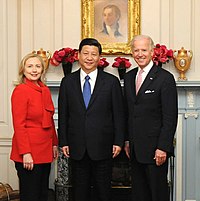Main article: Foreign relations of China
Chinese President Xi Jinping holds hands with fellow BRICS leaders at the 2014 G20 Brisbane summit in Australia
Under its interpretation of the One-China policy, Beijing has made it a precondition to establishing diplomatic relations that the other country acknowledges its claim to Taiwan and severs official ties with the government of the Republic of China. Chinese officials have protested on numerous occasions when foreign countries have made diplomatic overtures to Taiwan,[192] especially in the matter of armament sales.[193]
Much of current Chinese foreign policy is reportedly based on Premier Zhou Enlai's Five Principles of Peaceful Coexistence, and is also driven by the concept of "harmony without uniformity", which encourages diplomatic relations between states despite ideological differences.[194] This policy may have led China to support states that are regarded as dangerous or repressive by Western nations, such as Zimbabwe, North Korea and Iran.[195] China has a close economic and military relationship with Russia,[196] and the two states often vote in unison in the UN Security Council.[197][198][199]
Chinese President Xi Jinping with U.S. Secretary of State Hillary Clinton and Vice President Joe Biden, 14 February 2012
Trade relations
In recent decades, China has played an increasing role in calling for free trade areas and security pacts amongst its Asia-Pacific neighbours. China became a member of the World Trade Organization (WTO) on 11 December 2001. In 2004, it proposed an entirely new East Asia Summit (EAS) framework as a forum for regional security issues.[200] The EAS, which includes ASEAN Plus Three, India, Australia and New Zealand, held its inaugural summit in 2005. China is also a founding member of the Shanghai Cooperation Organization (SCO), along with Russia and the Central Asian republics.In 2000, the United States Congress approved "permanent normal trade relations" (PNTR) with China, allowing Chinese exports in at the same low tariffs as goods from most other countries.[201] China has a significant trade surplus with the United States, its most important export market.[202] In the early 2010s, US politicians argued that the Chinese yuan was significantly undervalued, giving China an unfair trade advantage.[203][204][205] In recent decades, China has followed a policy of engaging with African nations for trade and bilateral co-operation;[206][207][208] in 2012, Sino-African trade totalled over US$160 billion.[209] China has furthermore strengthened its ties with major South American economies, becoming the largest trading partner of Brazil and building strategic links with Argentina.[210][211]


No comments:
Post a Comment